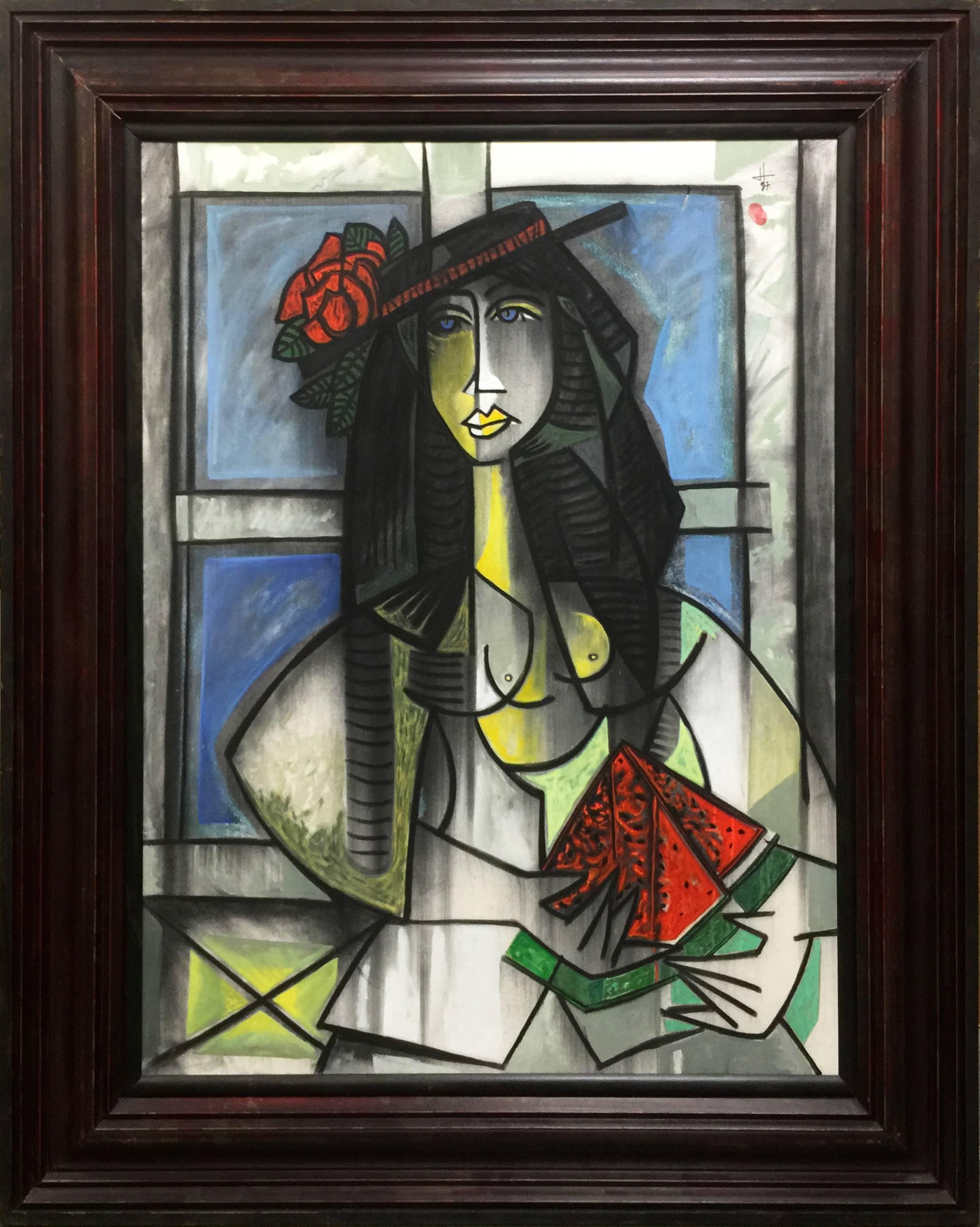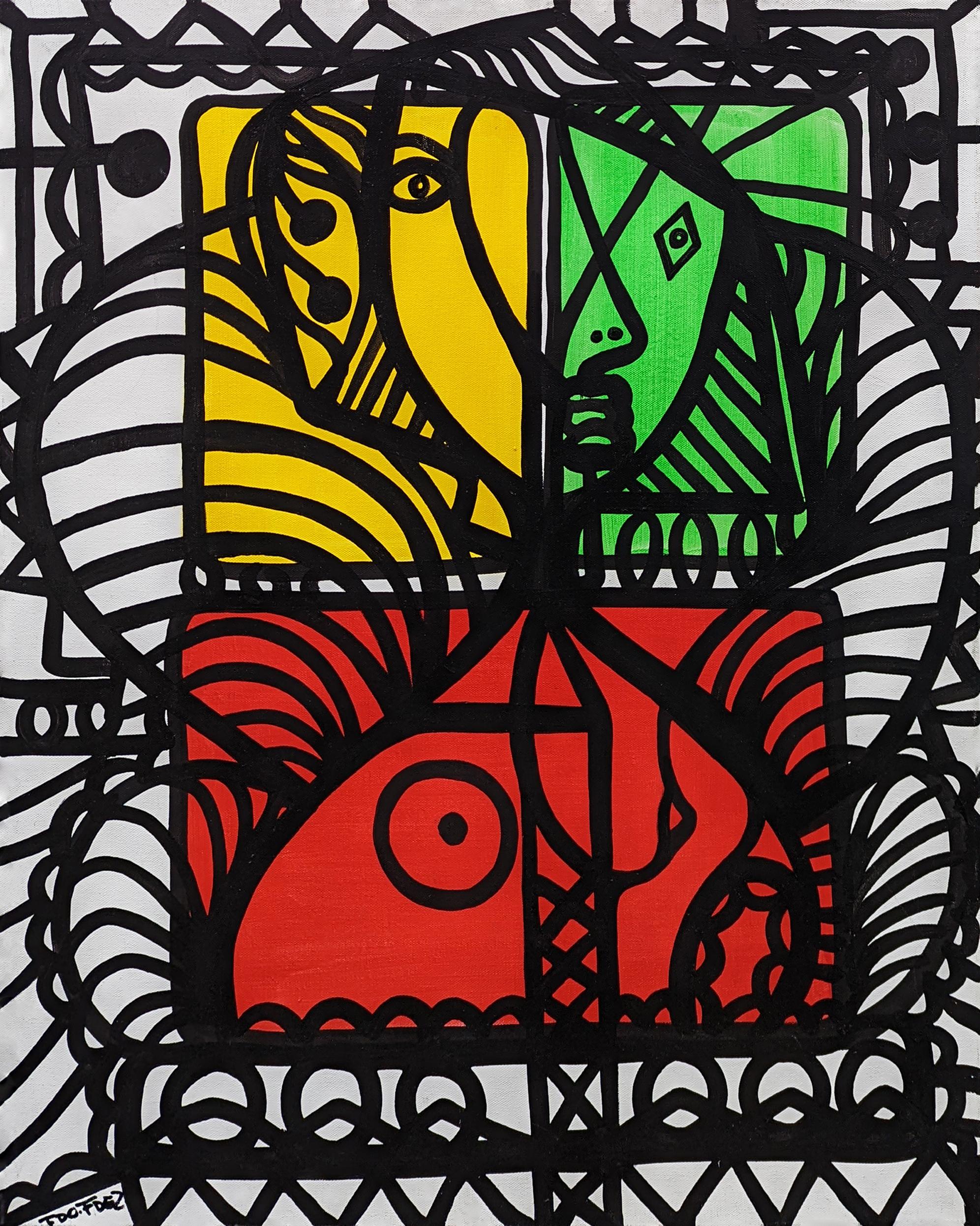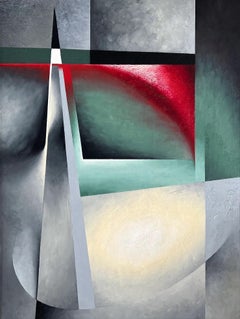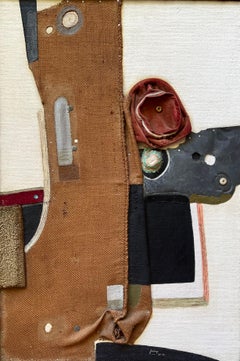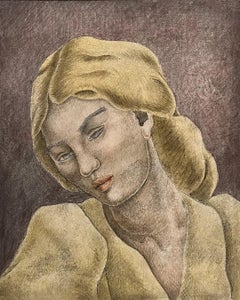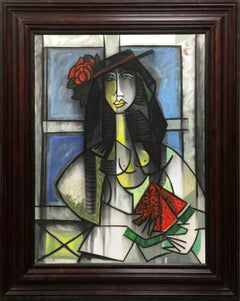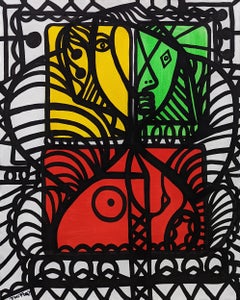Want more images or videos?
Request additional images or videos from the seller
1 of 6
Jerre H. MurryUntitled (Cubist Portrait)1945
1945
$3,250
£2,538.51
€2,877.70
CA$4,659.24
A$5,110.93
CHF 2,674.12
MX$60,830.25
NOK 33,775.74
SEK 31,682.25
DKK 21,492.29
About the Item
This work is part of our exhibition - America Coast to Coast: Artists of the 1940s
Untitled (Cubist Portrait), 1945, oil on masonite, signed and dated lower middle, 20 x 16 inches, remnant of exhibition label verso, perhaps exhibited at Murry's solo exhibition at the Los Angeles's Screen Cartoonists' Gallery, July , 1945, presented in its original frame
Jerre Murry was a California modernist painter. Born in Columbia, Missouri, Murry studied at the Detroit Academy of Art and worked as an artist for the Detroit News and Detroit Free Press. Murry traveled to the Bahamas, where he was inspired to paint modernist scenes of island life and people. By the early 1930s, Murry had relocated to Los Angeles, where he caught the attention of Synchromist painter Stanton Macdonald Wright, State Supervisor for the Federal Art Project (FAP) in Southern California. MacDonald Wright enrolled Murry into the FAP. Murry’s Gauguin-influenced painting Sun Image was exhibited together with other FAP artists at the Los Angeles County Museum of Art in 1936, and Murry was also included in the FAP exhibit at the Paris Exposition in 1937. Stendahl Galleries in Los Angeles, the Chamber of Commerce Gallery in Santa Barbara, and at the Los Angeles County Museum of Art also showed Murry’s work during the 1930s. Murry created a murals for Los Angeles Water & Power Company, the Boise, Idaho Post Office, and Glendale Junior College. In 1939, Murry's work was exhibited at the Golden Gate International Exposition and the New York World's Fair. He also was included in the All California Exhibition at the Los Angeles County Museum of art that same year. He went on to exhibit in Los Angeles at the Foundation of Western Art's Trends in Southern California Art shows in 1940 and 1941, at Raymond and Raymond Gallery in Hollywood and USC’s Elizabeth Holmes Fisher Gallery, and the Pasadena Museum of Art. In 1941, Murry had a solo show at En's Gallery, and exhibited in the San Francisco Bay Area, at the Oakland Art Gallery’s Annual Exhibition of Oil Paintings. Murry exhibited in the Second and Third Annual Exhibitions of the Artists of Los Angeles and Vicinity at the Los Angeles County Museum of Art in 1941 and 1942. For a short time, Murry became the director of the Spokane Art Center in Washington state, but returned to the Los Angeles area. In 1942, Murry had a critically acclaimed solo show at the Stendahl Galleries, comprising 71 of his oil paintings, watercolors, and drawings.
In 1945 at the time he created Untitled (Cubist Portrait), Murry again received critical notice for his exhibition at Los Angeles's Screen Cartoonists' Gallery. Writing in the Los Angeles Evening Citizen News, Herman Reuter commented, "An effect of tireless experimentation, no only in manipulation but in other painter's points of view, is discernable in an exhibition of oils and gouaches which Jerre Murry has hung in the gallery of the Screen Cartoonists. . . What the paintings probably indicate, somewhat more definitely, is a kind of searching for more positive original paths. Included in the exhibition are a number of small oils . . . These have a scope and authority about them which goes far." Murry is listed in Who Was Who in American Art and other standard references.
- Creator:Jerre H. Murry (1904 - 1973, American)
- Creation Year:1945
- Dimensions:Height: 20 in (50.8 cm)Width: 16 in (40.64 cm)Depth: 1 in (2.54 cm)
- More Editions & Sizes:20 x 16 inchesPrice: $3,250
- Medium:
- Movement & Style:
- Period:
- Condition:
- Gallery Location:Los Angeles, CA
- Reference Number:1stDibs: LU1859214264252
About the Seller
5.0
Gold Seller
Premium sellers maintaining a 4.3+ rating and 24-hour response times
1stDibs seller since 2022
17 sales on 1stDibs
- ShippingRetrieving quote...Shipping from: Los Angeles, CA
- Return Policy
More From This Seller
View AllPortrait (Untitled)
Located in Los Angeles, CA
Portrait (Untitled), c. mid 1930s, hammered copper, 11 1/2 x 8 1/2 inches
Beryl McCarthy Wynnyk was a California-based painter, sculptor, and craftsperson. She studied at the Califo...
Category
1930s American Modern More Art
Materials
Copper
Abstract
Located in Los Angeles, CA
This painting is part of our exhibition Charles Goeller: A Wistful Loneliness.
Oil on canvas, 29 x 22 inches, Signed on frame verso “Painted by Charles L. Goeller”
Exhibited:
(Perh...
Category
1930s American Modern Abstract Paintings
Materials
Oil
On a Spanish Motif
Located in Los Angeles, CA
On a Spanish Motif, 1956 – 1973, mixed media collage and painting on thick canvas, signed and dated lower right, 38 ½ x 26 inches, signed verso, labeled verso includes title, artist's name, address and size of work, presented in its original strip frame
Justin Faivre...
Category
1950s Abstract Mixed Media
Materials
Metal
Portrait of Helene Sardeau (The Artist’s Wife)
By George Biddle
Located in Los Angeles, CA
(Note: This work is part of our exhibition Connected by Creativity: WPA Era Works from the Collection of Leata and Edward Beatty Rowan)
Fresco, 20 x 16 inches unframed, 22 x 18 inch...
Category
1930s American Modern Portrait Paintings
Materials
Plaster, Mixed Media
Untitled (Modernist Three-Panel Screen)
Located in Los Angeles, CA
Untitled (Modernist Three-Panel Screen), 1948, mixed media on paperboard mounted into a three-section screen, 58 x 45 inches, signed and dated on each panel upper right
This work is part of our exhibition America Coast to Coast: Artists of the 1940s.
Charles Malcolm Campbell...
Category
1940s Cubist Mixed Media
Materials
Board
Two Figures
By Robert Chester Thomas
Located in Los Angeles, CA
This sculpture is part of our exhibition America Coast to Coast: Artists of the 1940s.
Two Figures, 1949, ebony wood, 24 x 7 x 5 inches, unsigned, but comes from Thomas' daughters and includes a copy of a 1949 photo of this work listing the artist's name, title of work and date
Robert Chester Thomas was a California sculptor. A native of Wichita, Kansas, Thomas moved with his family to Southern California as a child. During World War II, he joined the army and served for a time in the European theater. When he returned to California, he studied sculpture with David Green in Pasadena in 1946 and 1947, before taking advantage of the GI Bill in 1948 to study with Ossip Zadkine in Paris. He first exhibited at Galerie St. Placide as part of an exhibition of American artists working in late 1940s Paris...
Category
1940s American Modern Sculptures
Materials
Wood, Ebony
You May Also Like
UNKNOWN TITLE
By Jesus Fuertes
Located in Aventura, FL
Original painting on canvas. Hand signed and thumb printed on front by the artist. Canvas size 45 x 33 inches. Custom framed as pictured.
Artwork is in excellent condition. Certif...
Category
1990s Cubist Portrait Paintings
Materials
Canvas, Oil, Acrylic
$11,960 Sale Price
20% Off
Cubist portrait
Located in Wilton Manors, FL
Bernard Segal (1907-1986). Cubist portrait, ca. 1960. Gouache and watercolor on paper, sheet measures 10 x 13.5 inches. Unsigned. Estate stamp on vers...
Category
Mid-20th Century Cubist Abstract Paintings
Materials
Paper, Gouache
$350 Sale Price
50% Off
Cubist Female Woman
Located in Wilton Manors, FL
Joseph Kardonne (1911-1985). Nude Woman, 1966. Watercolor on paper, sheet measures 10 x 13.5 inches. Signed, dated and titled lower right. Excellent condition.
Born in Newark, New ...
Category
Mid-20th Century Cubist Abstract Paintings
Materials
Ink, Watercolor
CUBIST STUDY
By Fernando Fernandez
Located in Aventura, FL
Original painting on canvas. Hand signed lower front by Fernando Fernandez. Canvas is sretched.
Artwork is in excellent condition. Certificate of ...
Category
2010s Cubist Figurative Paintings
Materials
Canvas, Acrylic
$1,250 Sale Price
50% Off
Cubist Face
Located in Houston, TX
Vibrant French cubist face oil pastel painting in bold colors of yellow, orange and blues, circa 1960.
Original artwork on paper displayed on a white mat...
Category
1960s Figurative Paintings
Materials
Oil Pastel
Cubist Female Nude Woman
Located in Wilton Manors, FL
Joseph Kardonne (1911-1985). Nude Woman, 1968. Watercolor on paper, sheet measures 20 x 12.75 inches. Signed, dated and titled lower right. Excellent condition.
Born in Newark, New ...
Category
Mid-20th Century Cubist Abstract Paintings
Materials
Ink, Watercolor
More Ways To Browse
Cubist Portraits
Detroit Artists
Paris 1937 Exposition
Stanton Macdonald Wright
Large Vintage Canvas Art
Portrait Of A Lady
Puerto Rico
French Blue Painting
Lake Landscape Paintings
Village Oil Painting
Still Life With Fruits Painting
Antique Unframed Canvas Paintings
Jewish Museum
Flower Vase Oil On Canvas
French Floral Still Life Painting
Heart Painting
Layered Art
Art Medal
